Disney+Hotstar has lost the lucrative IPL deal. Is it now a fight for survival?
The OTT platform has competition closing in, even as it could lose millions of subscribers
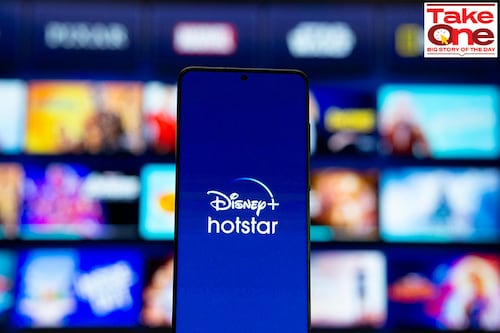

In early June, as anticipation grew over the digital and television rights of the lucrative Indian Premier League (IPL), Disney Star knew that it was on a rather sticky wicket.
The Mumbai-headquartered broadcaster—it has been telecasting the IPL on television for five years and on its digital platform Disney+ Hotstar for a little longer than that—knew the competition, especially for television rights, would be intense. The Board of Control for Cricket in India (BCCI) was holding the e-auction for the media rights for the next five years on June 12.
This time around, BCCI had divided the process into four packages. Domestic television broadcast rights, the most expensive one, carried a base price of Rs 18,130 crore, while for digital rights it was Rs 12,210 crore. BCCI was also offering two other rights, one for international broadcasting, which carried a base price of Rs 1,110 crore and a non-exclusive digital right for Rs 1,440 crore that included streaming rights for the playoffs and season openers. Disney Star was facing the heat from Sony, Viacom 18, and Zee Entertainment, among others.
“There wasn’t much hope on the television side," says a Disney Star employee, on condition of anonymity. “We were confident about Hotstar though." Disney+ Hotstar, launched in 2015, has 50 million paid subscribers and is India’s largest streaming platform. Much of it is thanks to IPL, and Disney Star was expected to go all out and bag the digital rights this time too. In 2018, Star India had won the digital and television rights for IPL for Rs 16,347.50 crore, and built Hotstar on the back of cheap data and widespread smartphone usage.
However, on June 14, after three days of intense bidding, while Disney Star won the television rights, it lost the digital rights to Viacom 18, which offered Rs 23,758 crore for 2023-2027. Despite the base price of TV rights being much higher than digital—Rs49 crore compared to Rs33 crore per match—Viacom 18 will pay around 50 crore per match for the digital rights. Viacom18 also won the non-exclusive digital rights, for which it will pay Rs 33.24 crore per match, for 98 matches between 2023 and 2027.
‘‘So digital turned out to be bigger than linear TV this season in IPL Media Rights," Arun Thakur, treasurer of BCCI, tweeted soon after. “In my view, the transparency of the whole process is truly winner no 1. Big thanks to fans.’’ Unlike previous auctions, where bids for the entire period were considered, this time around the auctions were on a per-match basis. The minimum bid increment value stood at Rs 50 lakh and none of the stakeholders, including BCCI, would know the bids until the highest one was declared.
“We made disciplined bids with a focus on long-term value," said Rebecca Campbell, chairman, International Content and Operations, Walt Disney, soon after the deal was announced. “We chose not to proceed with the digital rights, given the price required to secure that package. IPL is an important component of our portfolio of television channels in India, providing an incredible opportunity for us to showcase The Walt Disney Company’s powerful global brands and iconic storytelling, as well as Disney Star’s impressive collection of local original content, to millions of viewers in India." Disney Star is yet to respond to a detailed questionnaire from Forbes India.
Yet, it’s a bitter pill to swallow. Over the past few years, the platform had become the mainstay of IPL viewership. In 2022, during a Chennai Super Kings versus Mumbai Indians match, peak viewership was 8.3 million, while for a Chennai Super Kings versus Royal Challengers Bangalore it was 8.2 million. A year earlier, Hotstar saw peak viewership of 10 million.
“There is no doubt that the loss of the digital [OTT] rights is a big blow to the business prospects of Disney+ Hotstar," says Constantinos Papavassilopoulos, principal analyst at London-based technology consultancy firm Omdia. “Disney+ Hotstar (and Hotstar before the bundling with Disney+ in April 2020) based its dominance in the Indian online video market on the back of the IPL rights. We estimate that Disney+ Hotstar is facing the threat of losing between 30 and 40 percent of its subscribers after losing the IPL rights." This means, with over 50 million paid subscribers, Disney+ Hotstar stands to lose nearly 20 million users. 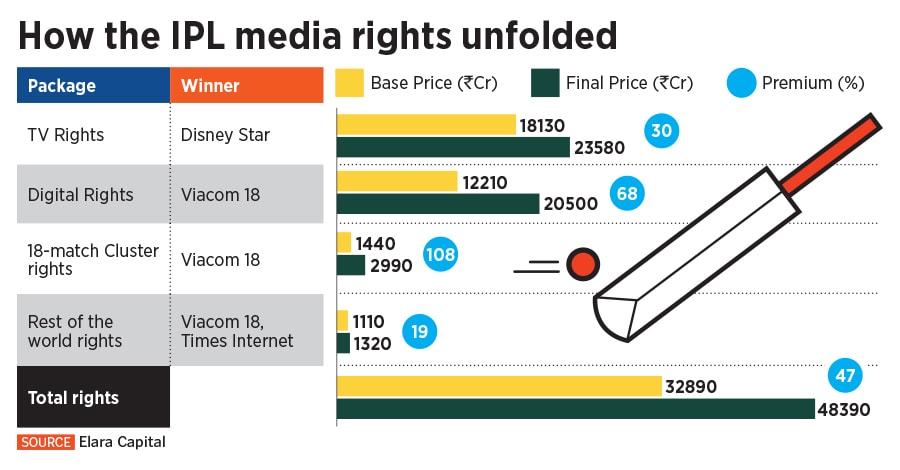
For now, Disney Star is clear that the loss of IPL rights won’t hit them hard.
“We will be exploring other multiplatform cricket rights, including future rights for International Cricket Council [ICC] and BCCI, which we currently hold through the 2023 and 2024 seasons, respectively," adds Campbell. “Additionally, we hold Pro Kabaddi League rights, Indian Super League football rights, as well as various international sports rights, including the Wimbledon Championships and the English Premier League."
In May, Disney Hotstar had said that the streaming service’s average monthly revenue per paid user increased in the quarter to reach $0.76 (Rs 58.83), compared to $0.49 (Rs 37.93) in the corresponding quarter last year. However, this number pales in comparison to the global average monthly revenue per paid user of Disney+, which is $6.33. With the loss of IPL, this could take a hit.
Streaming viewership for IPL has seen a steady growth with the league registering 421 million viewers last year, compared to 375 million and 325 million in 2020 and 2019 respectively. The IPL’s digital viewership is expected to touch 523 million in 2023. In contrast, IPL"s TV viewership dropped to 380 million last year, compared to 405 million in 2020 and 462 million in 2018.
“However, not all looks negative for Disney Star," says Jun Wen Woo, senior analyst, TV & Online at Omdia. “IPL monetisation still favours TV over OTT. Looking at advertising revenue alone, TV rights have brought in, on average for the last five years, six to seven times more money to Disney Star than OTT rights. It is expected that even in the next three years, IPL monetisation will still strongly favour TV, with a split of TV:OTT around 80 to 20 percent. Where revenue is concerned, the loss of the OTT rights will not be so severe for Disney Star."
At the end of 2021, Omdia estimated that India had 73 million paying subscriptions, up by 20 million (37 percent) in 2020. “The growth pattern will continue unabated in the rest of this decade and Omdia expects the Indian online video [OTT] subscriptions cross 100 million, well below the middle of this decade [end of 2025]," adds Papavassilopoulos. “The entry of new players will be a factor, but equally important is the huge investment in Indian original content by all major players (Netflix and Amazon Prime Video, Disney+ Hotstar, ZEE5, Voot Select, SonyLiv, Eros Now, ALT Balaji, MX Player)."
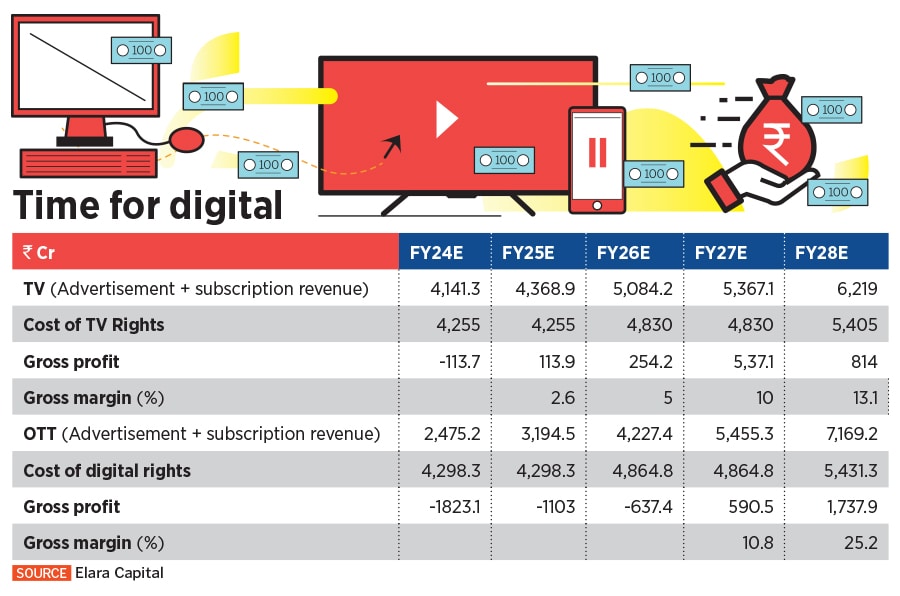
“Hotstar’s initial growth was built on the basis of IPL rights. Not only did that lead to dominance in India, accounting for more than half of all paid OTT subscribers, but also a significant part of Disney+’s global paid subscribers," says Balu Nayar, former MD of IMG, and principal architect of the IPL.
That certainly must have given Disney enough impetus when it came to acquiring 21st Century Fox, particularly as it chases high-growth markets such as India. In June 2018, Disney acquired Rupert Murdoch’s 21st Century Fox for $71 billion. Among other businesses, Star India also became a part of Disney. Of the total deal size, the value assigned to the Indian part was $14-16 billion—a majority of which was due to Star India having acquired the IPL rights in 2017 for five years. “As the Disney investor story was focussed on paid subscribers for Disney+, Hotstar accounted for over 35 percent of Disney+’s paid subscriber base worldwide. This probably played an important part in the Star acquisition," adds Nayar.
While the acquisition is only one part of it, the IPL definitely helped grow the platform’s subscriber base. In Q1FY21, Disney+ Hotstar had 29.2 million subscribers, growing to 45.9 million by Q1FY22. “We ended the quarter with nearly 138 million global paid Disney+ subscribers, reflecting close to 8 million net additions for the period. A little over half of those were from Disney+ Hotstar, which benefited from the new IPL season," said Christine McCarthy, senior executive vice president and chief financial officer, Walt Disney Company, at an investor call in May 2022. Meanwhile, for the same quarter, Netflix saw an erosion of close to 200,000 in its global subscriber base.
As of April 2022, Disney+ Hotstar accounts for almost 50 percent of India’s total subscriber-based online video market share, followed by 9 percent for Amazon Prime Video, 8 percent for Netflix, and the rest for other players, according to Omdia. Voot, through which Viacom18 is likely to telecast the IPL, accounts only for 2 percent. ““IPL is one of the three marquee cricketing rights that has played a pivotal role in building scale for Disney+ Hotstar. It has allowed the platform to bring in ad dollars as well as paid subscriptions," says Mihir Shah, vice president, Media Partners Asia.
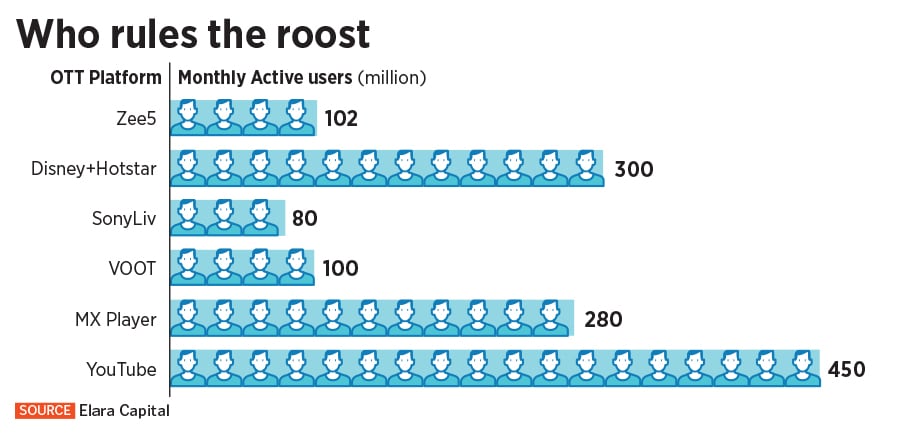
Now that the OTT platform has lost its digital media rights, Shah believes Disney+ Hotstar is likely to lose around 15 million subscribers. While it does have other sports and entertainment content, can it match up to the pull of the IPL and the willingness to pay? Analysts believe not. Shah adds, “Retaining the upcoming bids for ICC and BCCI rights will thus be critical, but equally challenging."
Of the total digital advertising revenue that Disney+ Hotstar makes, says Karan Taurani, senior vice president at Elara Capital, “close to 65 to 70 percent is driven by IPL. So, there will clearly be a negative impact on the platform, since advertising revenue will potentially flow to other platforms." As per news reports, in the coming IPL season, advertising rates are expected to increase by 20 percent, whereas, on digital, prices are expected to increase by 60 to 70 percent. Yet again, Disney+ Hotstar is likely to lose out.
BCCI’s decision to split the broadcast rights into digital and television will also mean advertisers have the choice to decide on their preferred platform. Already, digital advertising in India is pegged at Rs 36,300 crore, the most significant contributor to advertising revenues, according to a FICCI-EY report.
“In terms of advertising verticals, key segments such as e-commerce, FMCG, auto and banking dominate the overall ad pie across TV and digital (60% of the ad pie)," says a report by Elara Capital. “However, in case of IPL rights being sold separately, expect stiff competition between the TV and digital platforms for advertising budgets. We expect some verticals such as fintech, commerce, edtech, and EV to see a rapid shift to digital, whereas FMCG and auto may continue to rely heavily on TV for their mass campaigns." Cricket’s share in total sports sponsorship spending was 60 percent in 2019, rising to 64 percent in 2020, and 77 percent in 2021.
“In terms of break-even, we estimate TV to attain profitability in the second year itself, as related premiums were limited over the base price," says the Elara Capital report. “For the digital segment, the break-even may ensue in the fourth year due to hefty content cost, propelled by sharp premiums on package B and C of the media rights. However, digital has the potential to generate a gross margin of 24 percent in the fifth year, helped by strong growth prospects and future monetisation models (Web 3.0), as compared with TV with its gross margin peaking at 13 percent."
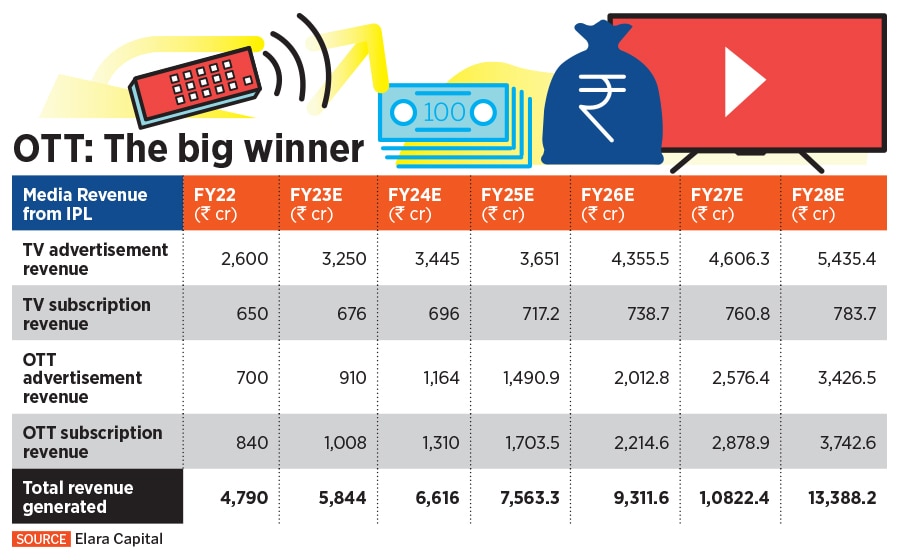
Though Disney has a great content library, like Netflix and Amazon Prime India, Disney+ Hotstar will need to invest in original Indian content. Taurani adds, “If they’ve spent so much money buying IPL rights, they definitely have the wherewithal to invest big time on original content." Although this might not entirely make up for lost subscribers, it will reduce the impact. Some of Hotstar’s Original web series content includes Empire, Human, Aarya, Special Ops, Criminal Justice, and City of Dreams.
So far Disney+ Hotstar was enjoying a 16 percent market share in the advertising-based video-on-demand (AVOD) space Taurani expects it to shrink to 7 percent. At the same time, Voot’s market share is likely to go up to at least 10 to 12 percent. “Voot has an unmatched advantage because of Jio’s large 4G subscriber base. The minute a platform depends on a third party for distribution, the average revenue per user (ARPUs) drops. With Reliance-Viacom18 that won’t be the case in fact it will help boost ARPUs," Taurani adds.
Jio already has 400 million users and Viacom 18, with Jio’s backing, will look to tap the platform for streaming services, in addition to using JioTV, Jio’s streaming service, helping it reach an audience almost 10 times larger than Disney+ Hostar’s total subscriber base. Viacom18 is a joint venture between Reliance Industries and Paramount Global (formerly ViacomCBS). In January 2022, media baron James Murdoch and former Star India head Uday Shankar’s Bodhi Tree Systems picked up a 39 percent stake in Viacom18, making ViacomCBS a minority player with only a 10 percent stake. Reliance retained a majority stake in Viacom18 after the sale to Murdoch and Shankar.
Disney+ Hotstar will also have to turn its attention to original content. “Disney+ Hotstar produced only seven Indian originals between 2014 and 2019," says Papavassilopoulos. “But, according to Disney releases earlier this year, between the second half of 2022 and the end of 2023, Disney+ Hotstar will produce 100 Indian originals. That says a lot about their change of strategy."
“For original Indian content, Netflix has been the largest investor among OTT video services for five consecutive years," Jun of Omdia says. “It is spending around $200 million in 2022, followed by Amazon Prime Video, around $140 million. Disney+ Hotstar has been stepping up its investment to compete with other US giants, with $25 million spent in Indian originals."
In addition, it will also need to ramp up its offering of regional content. “It is very important for Disney+ Hotstar to increase its investment in original production and to expand its content offering beyond the Hindi language, first to South Indian markets (Tamil, Telugu, Malayalam, Kannada) and later to other Indian regional languages," adds Jun. “Currently, Disney+ Hotstar is offering content (library not original) in eight regional languages."
The platform still has Disney’s massive entertainment portfolio, in addition to the upcoming season of the popular show Koffee With Karan.
In the live sports events segment, it has streaming rights for Wimbledon, ICC Men"s T20 World Cup, Indian Super League, and Pro Kabbadi League, among many others. But Nayar says, “Disney+ Hotstar"s future in India depends on the corporate significance that it has for Disney corporate, and Disney+. Are the Indian OTT market’s long-term prospects attractive enough for Disney? Disney"s willingness to spend on IPL TV rights rather than digital rights is probably an indicator." Disney+ has been banking hard on sports broadcast, earmarking $10.6 billion for it in FY22.
This is because competition in India’s OTT sector is growing significantly. According to EY, over 2,500 hours of original content was created for OTT platforms in 2021, including over 100 direct-to-digital films. These were extensively marketed, and led to increased demand for OTT subscriptions. It also helps that OTT subscriptions are mostly used by 3 to 3.5 persons, which means a subscriber base of 40 million households could have a potential reach of 120 to 140 million people, or even more.
“Hosting more than 55 OTT video services in 2021, the Indian market is one of the largest internationally," says Jun. “Since 2016, when Jio slashed mobile broadband pricing by 70 percent, India has offered one of the most fertile environments for the growth of online video. India"s online streaming segment is growing fast, and new OTT services continue to launch every year. Omdia anticipates merger and acquisition activity in the coming years."
This means Hotstar has some serious fight to put up. During a conversation with Forbes India in July 2021, Sunil Rayan, the then head and president of Disney+ Hotstar had said, “With all this [sports portfolio] and our entertainment portfolio, we don"t [need to] worry about the competition."
Maybe it is time for a rethink.
First Published: Jul 06, 2022, 15:09
Subscribe Now